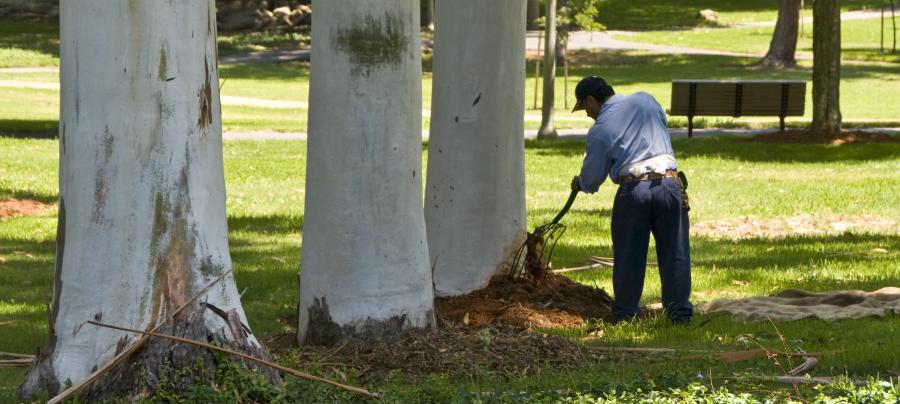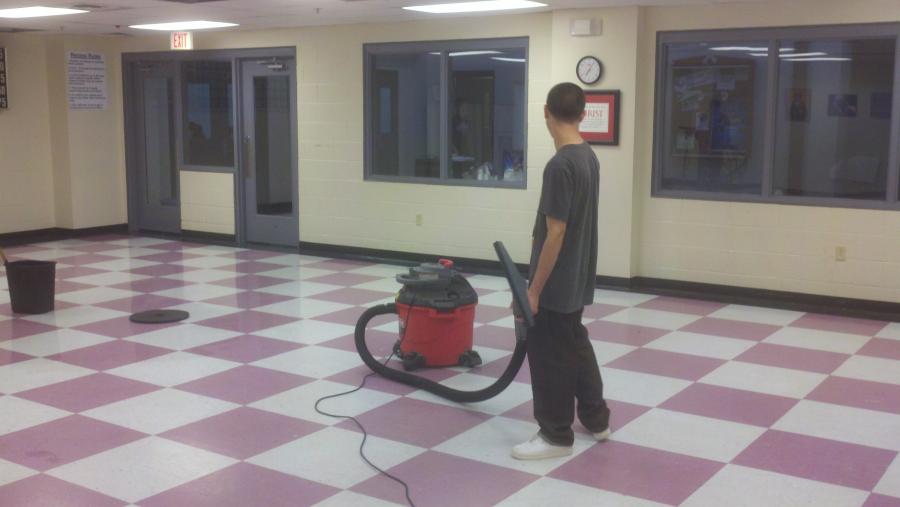
A downloadable version of this lesson is available here:
This is a field trip and applied learning lesson for undergraduates and graduate students in the natural sciences. Though natural science students know the epistemological methods of objective experimental design, quantitative analysis, and testability, they may be less nimble in considering qualitative and human dimensions of environment. They may also conflate “environment” with “nature,” while neglecting the critical interfaces between human social roles and the built environment. This lesson aims to get natural science students involved in empathic and perspective-building interactions with the less privileged members of their campus community. It will also expand their sense of what counts as ecological work and how environmental justice can factor into equitable socio-environmental solutions. This is the third lesson in a three-part series. It will be helpful to have completed Lesson 1, Sociological Approaches to the Environment, (but it is not necessary to have completed Lesson 2, Paradigm Shifts Applied to the Food System) before proceeding to this exercise.
- Consider how the campus environment serves as a microcosm of our highly stratified society.
- Interrogate the meaning of “environment” to include human infrastructure and perceive how the quality and health of environments differ across campus.
- Think of students as “consumers” of education, residence, and food on campus and consider the role of less privileged “producers” in this hierarchy.
- Learn and apply sociological methods to the study of campus society, individuals, and their environments.
- Employ eco-psychology to assess the mental and physical health of various environments.

Do you recognize this custodian? Consider the people who work on campus to make the campus work, but who are seldom known by name, let alone celebrated for their accomplishments. List 2-3 people or occupations on campus who work in the same places as you do, but whom you may have little to no contact with because of the stratification of roles. How is this a sociological inquiry? Is it in any way also an environmental one? What eco-social insights might come of knowing more about cross-class relationships on campus, and beyond?
Campus Labor: An Eco-Sociological Approach
This active lesson is appropriate for undergraduate and graduate students. It is designed to be conducted without extensive theory or background reading beyond Lori Peek’s introduction to Sociology that is used in Lesson 1. The idea is to get students to look for socio-environmental puzzles in their everyday lives by seeking campus locales that reveal structural hierarchies. Ideally, students will perceive how resources are allocated unequally based on perceptions of value that have a basis in economics and prestige as defined by the administration. Here, “environment” means a space designed and maintained by the university, whether indoors or outside.
-
Start the conversation by asking the students what constitutes an “environment,” and within various definitions, what “environmental quality” means. Note physical, emotional, and social valences of these ideas, which are usually far removed from a quantifiable ecological “quality” such as biodiversity, purity, or interspecies communities.
-
Have students select from four categories: Athletics, Dormitories, Food Services, or Campus Landscaping. Organize them in four groups according to their interest—they are now known as the “consumers” of their chosen locale for this lesson. A couple of questions to consider are:
Have they ever previously considered themselves to be “consumers” on campus? Why or why not?
Have they ever considered the support staff to be “producers”? Why or why not?
Does the explicit classification of roles in this way provide another perspective as it relates to their perceptions of hierarchy? How so?
-
Have each group pull up a campus map and circle facilities for athletics, residences, food service, or campus gardens and lawns. Some of these places may be inaccessible to most students, such as varsity athletic training facilities. Some may be highly variable and hierarchical, such as the quality of dormitories or dining halls. Have an initial conversation about their impressions of access versus exclusivity in each of these spaces. This may include reputation, personal experience, paywalls, or the luck of the draw (dorm assignments).
-
In preparation for their field trip and discussions with support staff, have them generate a basic interview/survey that they could conduct with staff in an informal setting. It could be qualitative or quantitative in design; both approaches are important to sociologists. Surveys are quantitative if you change questions to a 1-10 format—e.g.,“How does the space make you feel?” ranges from 1 (terrible) to 10 (ecstatic). The field trip may require some planning and/or coordination to ask the questions to staff who are working on the clock. For instance, students may approach staff that they see regularly and ask them if they have time and interest to participate in a brief survey. If the staff is interested but does not have time at that moment, they may need to coordinate an alternative time to meet. The hurdles inherent to facilitating these conversations with campus staff may reveal how these producers occupy a different “environment” within the same spatio-temporal dimensions and may also help guide the questions. The survey may include questions, such as:
What is your role here? Do you feel valued in this space in your pay and treatment?
What benefits do you see as a member of this community?
What disadvantages come with your role?
Do you feel respected within the campus community? Do these feelings differ depending on whom you’re interacting with?
Generally, where do you spend the most time at work? Do you have a place to spend breaks?
How does the physical space make you feel (this relates to eco-psychology)?
Are there any practical or actionable changes that you think would improve your experience while working on campus?
-
Equip students with guidelines on how to conduct interviews with these “Interview Best Practices”:
Introduce yourself, the class you are taking, and the survey you would like to administer. You may also go into brief detail as to what the survey is about (see below).
Ask if they have time for a few questions that may take 15 minutes. Remember, participation is not mandatory; if they do not wish to participate, move on. Additionally, and it goes without saying, treat all realized and potential interviewees with the utmost respect. After all, staff members are doing you a service both with the interviews and through their work.
Example: Hi my name is ________. I am taking _______ class, and we are learning about environmental sociology. We would love to have feedback from campus community members about their experiences on campus and how that relates to their feelings of well-being. Our goals are to increase a sense of community on campus and practice methods used by sociologists, such as survey interviews. This survey should take about 15 minutes. Do you have time? Would you like to participate? This survey is anonymous, but can I ask your name? Thank you, okay, let’s get started. [Ask applicable interview questions…] I really appreciate your time and it has been great talking with you. I think this information will be really useful in understanding the experiences of campus community members so that we can make this a better space for all.
-
Students now take field trips to their chosen location and approach the staff members who make these spaces run for in-person interviews. (Note as before that some students may need to set up a time to follow up with staff, if they are not able to connect with anyone during the time allotted.) Students should not take photos of interviewees, but if they wish to take photos of the locations themselves for use in analysis, they may.
-
In this session, have students in the same categories synthesize their qualitative/quantitative findings across interviews with the following activities:
Have each group discuss and reflect on their own experiences as “consumers” (students) within their chosen locations. They may refer to the survey for inspiration—e.g., do they feel respected/valued within the space? How does the space make them feel—both from a physical standpoint (Is it clean/orderly?); or on a deeper level (Does the space elicit feelings of pride or relaxation?). Next, ask them to compare their responses to those they gathered from the surveys. In what ways are they the same and how are they different?
Have each of the four large groups present major trends (quantitative/macro), and poignant anecdotes from their conversations (qualitative/micro). (An interview of a janitor might reveal that they are 3rd shift workers who are stressed by their nocturnal schedule).
Generate a list of specific environments on campus that the group would consider healthy (physically and mentally) versus unhealthy. Share photos and anecdotes from these spaces. Update the campus map to feature these socio-environmental places.
-
Review Lori Peek’s statements on the structure/agent debate and social stratification (29:15-32:40). Synthesize the social with the environmental by asking these questions:
How do elements of privilege including status, money, and luck often correlate with healthy environments?
How does disadvantage display in opposite ways: subordination, low pay, little respect?
Are there race, class, gender, or other identity markers that reveal intersectional trends?
How is socio-environmental privilege made possible by its inverse (i.e., others who suffer disadvantage)?
What benefits and improvements in university policy or infrastructure might deliver greater equality across the faculty/staff and consumer/producer divides?
-
Conclude the lesson (or start a new session) with consideration of the Global South and how developed Euro-American, ex-colonist economies (the Global North) have benefitted from their colonial histories to develop modern infrastructure, democratic freedoms, and control over the conditions of production. Review the brief article The Global North’s Environmental Impact on the Global South by Sofia Irfan. This is a zoom-out from the campus microcosm to the global scene. Then, have students consider:
What are some socio-environmental effects of global stratification?
How does campus inequality reflect the Global South’s struggles with poverty, lack of human rights, and depletion of human and natural resources? As a space of extreme privilege, how does your campus not adequately capture the stark divide between the Global North’s consumerism and the Global South’s roles as producer/dumping ground?
-
As an optional lesson extension, the instructor could facilitate the sharing of the surveys’ findings with university administrators. As homework on the class discussion board, learners could list their leading takeaways from the survey and work together to compose a respectful but honest letter to the administration about improvements to the staff experience (without using the names of staff members).
-
Bright Lights, Big City Ills: Artificial Light and the Night Shift
This qualitative analysis of the custodians' experience at a prestigious university focuses on the 3rd shift and its mental and physical tolls. These low-pay, high-risk staff jobs are disproportionately occupied by elderly, African-American workers.
Bogard, P. (2015). Bright Lights, Big City Ills: Artificial Light and the Night Shift. In: C. Robertson & J. Westermann (Eds.), Working on Earth: Class and Environmental Justice. University of Nevada Press.
-
Sustainable Interiors: Green Design Methods and its Influence on Ecopsychology
This paper addresses how sustainable design methods can be incorporated into the field of interior design to benefit the environment, while simultaneously improving the beauty of the space. It discusses current sustainable design methods such as using renewable resources and materials, energy efficient heating and cooling systems, the use of plants to reduce carbon dioxide levels, and the use of large windows to harvest natural sunlight. Chapter four explores the profound effects of interior green spaces on human psychology. New policy recommendations are presented as well, such as valuing ecosystem services, using biomimicry in design, integrating biophilia into design, and only using recycled materials in the design process.
O’Reilly, T.M. (2018). Sustainable Interiors: Green Design Methods and its Influence on Ecopsychology (student thesis). Environmental Studies at Digital Research@Fordham. Sustainable Interiors_Green Design Methods.pdf